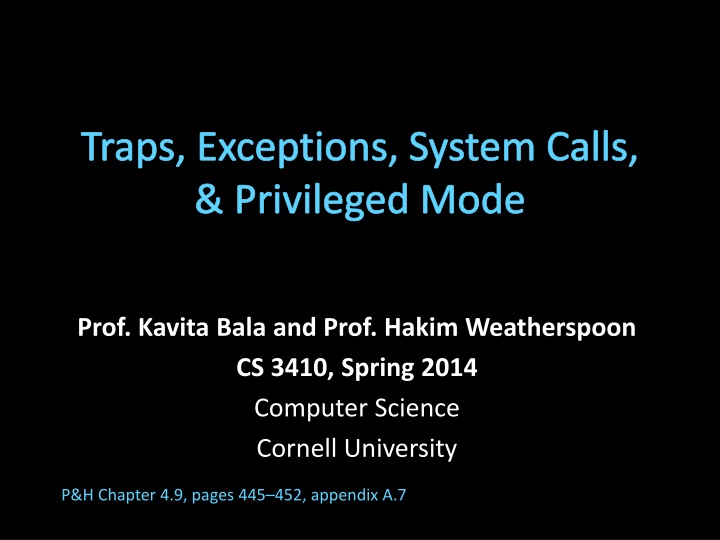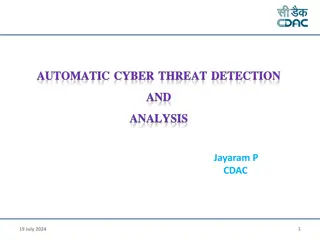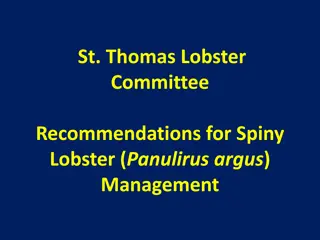
Heartbleed Security Bug and Buffer Overflow Vulnerabilities
Explore the Heartbleed security bug in OpenSSL library and its impact on Internet security. Learn about buffer overflow vulnerabilities and the importance of bounds checking in CS3410.
Download Presentation

Please find below an Image/Link to download the presentation.
The content on the website is provided AS IS for your information and personal use only. It may not be sold, licensed, or shared on other websites without obtaining consent from the author. If you encounter any issues during the download, it is possible that the publisher has removed the file from their server.
You are allowed to download the files provided on this website for personal or commercial use, subject to the condition that they are used lawfully. All files are the property of their respective owners.
The content on the website is provided AS IS for your information and personal use only. It may not be sold, licensed, or shared on other websites without obtaining consent from the author.
E N D
Presentation Transcript
Traps, Exceptions, System Calls, & Privileged Mode Prof. Kavita Bala and Prof. Hakim Weatherspoon CS 3410, Spring 2014 Computer Science Cornell University P&H Chapter 4.9, pages 445 452, appendix A.7
Heartbleed Security Bug Heartbleed is a security bug in the open-source OpenSSL cryptography library, widely used to implement the Internet's Transport Layer Security (TLS) protocol. worst vulnerability found since commercial traffic began to flow over the internet. Forbes, massive Internet Security Vulnerability Here s where you need to do, Apr 10 2014 17% (0.5million) secure web servers vulnerable to bug Netcraft, Ltd, Apr 8, 2014 Amazon, Akamai, GitHub, Wikipedia, etc
Heartbleed Security Bug How does it work? Lack of bounds checking Buffer over-read http://en.wikipedia.org/wiki/Heartbleed
Heartbleed Security Bug How does it work? Lack of bounds checking Buffer over-read SW allows more data to be read than should be allowed Malloc/Free did not clear memory Req with a large length field could return sensitive data Unauthenticated user can send a heartbeat and receive sensitive data
Heartbleed Security Bug How does it work? Lack of bounds checking Buffer over-read Similar bug/vulnerability due to Buffer overflow Lab3 Browser implementation lacks bounds checking
Heartbleed Security Bug Buffer Overflow from lec12 and lab3 saved ra saved fp blue() { pink(0,1,2,3,4,5); } pink(int a, int b, int c, int d, int e, int f) { orange(10,11,12,13,14); } orange(int a, int b, int c, int, d, int e) { char buf[100]; gets(buf); // read string, no check! } buf[100] saved regs arguments saved ra saved fp saved regs local variables arguments fp saved ra saved fp local variables sp What happens if more than 100 bytes is written to buf?
Takeaway Worst Internet security vulnerability found yet due systems practices 101 that we learn in CS3410, lack of bounds checking!
Big Picture How do we protect programs from one another? How do we protect the operating system (OS) from programs? How does the CPU (and software [OS]) handle exceptional conditions. E.g. Div by 0, page fault, syscall, etc?
Goals for Today Operating System Privileged mode Hardware/Software Boundary Exceptions vs Interrupts vs Traps vs Systems calls
Next Goal How do we protect programs from one another? How do we protect the operating system (OS) from programs?
Privileged Mode aka Kernel Mode
Operating System Some things not available to untrusted programs: MMU instructions, Exception registers, HALT instruction, talk to I/O devices, OS memory, ... Need trusted mediator: Operating System (OS) Safe control transfer Data isolation untrusted P1 P2 P3 P4 VM filesystem net driver driver MMU disk eth
Operating System Trusted mediator is useless without a privileged mode : Any program can muck with TLB, PageTables, OS code A program can intercept exceptions of other programs OS can crash if program messes up $sp, $fp, $gp, Wrong: Make these instructions and registers available only to OS Code OS Code == any code above 0x80000000 Program can still JAL into middle of OS functions Program can still muck with OS memory, pagetables,
Privilege Mode CPU Mode Bit / Privilege Level Status Register Mode 0 = untrusted = user domain Privileged instructions and registers are disabled by CPU Mode 1 = trusted = kernel domain All instructions and registers are enabled Boot sequence: load first sector of disk (containing OS code) to well known address in memory Mode 1; PC well known address OS takes over initialize devices, MMU, timers, etc. loads programs from disk, sets up pagetables, etc. Mode 0; PC program entry point (note: x86 has 4 levels x 3 dimensions, but only virtual machines uses any the middle)
Terminology Trap: Any kind of a control transfer to the OS Syscall: Synchronous (planned), program-to-kernel transfer SYSCALL instruction in MIPS (various on x86) Exception: Synchronous, program-to-kernel transfer exceptional events: div by zero, page fault, page protection err, Interrupt: Aysnchronous, device-initiated transfer e.g. Network packet arrived, keyboard event, timer ticks * real mechanisms, but nobody agrees on these terms
Sample System Calls System call examples: putc(): Print character to screen Need to multiplex screen between competing programs send(): Send a packet on the network Need to manipulate the internals of a device sbrk(): Allocate a page Needs to update page tables & MMU sleep(): put current prog to sleep, wake other Need to update page table base register
System Calls System call: Not just a function call Don t let program jump just anywhere in OS code OS can t trust program s registers (sp, fp, gp, etc.) SYSCALL instruction: safe transfer of control to OS Mode 0; Cause syscall; PC exception vector In MIPS, jump to 0x8000 0180 for an exception or 0x8000 0000 a TLB miss MIPS system call convention: user program mostly normal (save temps, save ra, ) but: $v0 = system call number, which specifies the operation the application is requesting
Invoking System Calls int getc() { asm("addiu $2, $0, 4"); asm("syscall"); } char *gets(char *buf) { while (...) { buf[i] = getc(); } }
Libraries and Wrappers Compilers do not emit SYSCALL instructions Compiler doesn t know OS interface Libraries implement standard API from system API libc (standard C library): getc() syscall sbrk() syscall write() syscall gets() getc() printf() write() malloc() sbrk()
Where does OS live? In its own address space? But then syscall would have to switch to a different address space Also harder to deal with syscall arguments passed as pointers So in the same address space as process Use protection bits to prevent user code from writing kernel Higher part of VM, lower part of physical memory
Anatomy of an Executing Program 0xfffffffc top system reserved 0x80000000 0x7ffffffc stack dynamic data (heap) 0x10000000 .data static data code (text) .text 0x00400000 0x00000000 bottom system reserved
Full System Layout Typically all kernel text, most data At same Virtual Addr in every address space Map kernel in contiguous physical memory when boot loader puts kernel into physical memory 0xfff f OS Stack OS Heap OS Data OS Text 0x800 0 0x7ff f The OS is omnipresent and steps in where necessary to aid application execution Typically resides in high memory Stack Heap Data Text When an application needs to perform a privileged operation, it needs to invoke the OS 0x000 0 Virtual Memory
Full System Layout 0xfff f OS Stack OS Heap OS Data OS Text 0x800 0 0x7ff f Stack OS Stack Heap Data Text OS Heap OS Data OS Text 0x000 0 0x000 0 Virtual Memory Physical Memory
SYSCALL instruction SYSCALL instruction does an atomic jump to a controlled location (i.e. MIPS 0x8000 0180) Switches the sp to the kernel stack Saves the old (user) SP value Saves the old (user) PC value (= return address) Saves the old privilege mode Sets the new privilege mode to 1 Sets the new PC to the kernel syscall handler
SYSCALL instruction Kernel system call handler carries out the desired system call Saves callee-save registers Examines the syscall number Checks arguments for sanity Performs operation Stores result in v0 Restores callee-save registers Performs a return from syscall (ERET) instruction, which restores the privilege mode, SP and PC
Takeaway Worst Internet security vulnerability found yet due systems practices 101 that we learn in CS3410, lack of bounds checking! It is necessary to have a privileged mode (aka kernel mode) where a trusted mediator, the Operating System (OS), provides isolation between programs, protects shared resources, and provides safe control transfer.
Next Goal How do we protect programs from one another? How do we protect the operating system (OS) from programs? How does the CPU (and software [OS]) handle exceptional conditions? E.g. syscall, Div by 0, page fault, etc? What are exceptions and how are they handled?
Exceptions Exceptions are any unexpected change in control flow. Interrupt -> cause of control flow change external Exception -> cause of control flow change internal Exception: Divide by 0, overflow Exception: Bad memory address Exception: Page fault Interrupt: Hardware interrupt (e.g. keyboard stroke) We need both HW and SW to help resolve exceptions Exceptions are at the hardware/software boundary
Exceptions Code Stored in Memory (also, data and stack) compute jump/branch targets memory $$ $0 (zero) $1 ($at) A register file $29 ($sp) $31 ($ra) D D alu B +4 memory $$ addr inst PC din dout M control B imm extend new pc forward unit detect hazard Stack, Data, Code Stored in Memory Instruction Decode Write- Back Instruction Fetch ctrl ctrl ctrl Memory Execute IF/ID ID/EX EX/MEM MEM/WB
Exceptions EPC Code Stored in Memory (also, data and stack) Cause compute jump/branch targets memory $$ $0 (zero) $1 ($at) A register file $29 ($sp) $31 ($ra) D D alu B +4 memory $$ addr inst PC din dout M control B imm extend new pc forward unit detect hazard Stack, Data, Code Stored in Memory Instruction Decode Write- Back Instruction Fetch ctrl ctrl ctrl Memory Execute IF/ID ID/EX EX/MEM MEM/WB
Hardware/Software Boundary Hardware support for exceptions Exception program counter (EPC) Cause register Special instructions to load TLB Only do-able by kernel Precise and imprecise exceptions In pipelined architecture Have to correctly identify PC of exception MIPS and modern processors support this
Hardware/Software Boundary Precise exceptions: Hardware guarantees (similar to a branch) Previous instructions complete Later instructions are flushed EPC and cause register are set Jump to prearranged address in OS When you come back, restart instruction Disable exceptions while responding to one Otherwise can overwrite EPC and cause
Hardware/Software Boundary What else requires both HW and SW?
Hardware/Software Boundary Virtual to physical address translation is assisted by hardware Need both hardware and software support Software Page table storage, fault detection and updating Page faults result in interrupts that are then handled by the OS Must update appropriately Dirty and Reference bits (e.g., ~LRU) in the Page Tables
Hardware/Software Boundary OS has to keep TLB valid Keep TLB valid on context switch Flush TLB when new process runs (x86) Store process id (MIPs) Also, store pids with cache to avoid flushing cache on context switches Hardware support Page table register Process id register
Takeaway Worst Internet security vulnerability found yet due systems practices 101 that we learn in CS3410, lack of bounds checking! It is necessary to have a privileged mode (aka kernel mode) where a trusted mediator, the Operating System (OS), provides isolation between programs, protects shared resources, and provides safe control transfer. Exceptions are any unexpected change in control flow. Precise exceptions are necessary to identify the exceptional instructional, cause of exception, and where to start to continue execution. We need help of both hardware and software (e.g. OS) to resolve exceptions. Finally, we need some type of protected mode to prevent programs from modifying OS or other programs.
Next Goal What is the difference between traps, exceptions, interrupts, and system calls?
Recap: Traps Map kernel into every process using supervisor PTEs Switch to kernel mode on trap, user mode on return Trap: Any kind of a control transfer to the OS Syscall: Synchronous, program-to-kernel transfer user does caller-saves, invokes kernel via syscall kernel handles request, puts result in v0, and returns Exception: Synchronous, program-to-kernel transfer user div/load/store/ faults, CPU invokes kernel kernel saves everything, handles fault, restores, and returns Interrupt: Aysnchronous, device-initiated transfer e.g. Network packet arrived, keyboard event, timer ticks kernel saves everything, handles event, restores, and returns
Interrupts & Exceptions On an interrupt or exception CPU saves PC of exception instruction (EPC) CPU Saves cause of the interrupt/privilege (Cause register) Switches the sp to the kernel stack Saves the old (user) SP value Saves the old (user) PC value Saves the old privilege mode Sets the new privilege mode to 1 Sets the new PC to the kernel interrupt/exception handler
Interrupts & Exceptions Kernel interrupt/exception handler handles the event Saves all registers Examines the cause Performs operation required Restores all registers Performs a return from interrupt instruction, which restores the privilege mode, SP and PC
Example: Clock Interrupt Example: Clock Interrupt* Every N cycles, CPU causes exception with Cause = CLOCK_TICK OS can select N to get e.g. 1000 TICKs per second .ktext 0x8000 0180 # (step 1) save *everything* but $k0, $k1 to 0xB0000000 # (step 2) set up a usable OS context # (step 3) examine Cause register, take action if (Cause == PAGE_FAULT) handle_pfault(BadVaddr) else if (Cause == SYSCALL) dispatch_syscall($v0) else if (Cause == CLOCK_TICK) schedule() # (step 4) restore registers and return to where program left off * not the CPU clock, but a programmable timer clock
Scheduler struct regs context[]; int ptbr[]; schedule() { i = current_process; j = pick_some_process(); if (i != j) { current_process = j; memcpy(context[i], 0xB0000000); memcpy(0xB0000000, context[j]); asm( mtc0 Context, ptbr[j] ); } }
Syscall vs. Interrupt Syscall vs. Exceptions vs. Interrupts Same mechanisms, but Syscall saves and restores much less state Others save and restore full processor state Interrupt arrival is unrelated to user code
Takeaway It is necessary to have a privileged mode (aka kernel mode) where a trusted mediator, the Operating System (OS), provides isolation between programs, protects shared resources, and provides safe control transfer. Exceptions are any unexpected change in control flow. Precise exceptions are necessary to identify the exceptional instructional, cause of exception, and where to start to continue execution. We need help of both hardware and software (e.g. OS) to resolve exceptions. Finally, we need some type of protected mode to prevent programs from modifying OS or other programs. To handle any exception or interrupt, OS analyzes the Cause register to vector into the appropriate exception handler. The OS kernel then handles the exception, and returns control to the same process, killing the current process, or possibly scheduling another process.
Summary Trap Any kind of a control transfer to the OS Syscall Synchronous, program-initiated control transfer from user to the OS to obtain service from the OS e.g. SYSCALL Exception Synchronous, program-initiated control transfer from user to the OS in response to an exceptional event e.g. Divide by zero, TLB miss, Page fault Interrupt Asynchronous, device-initiated control transfer from user to the OS e.g. Network packet, I/O complete
Administrivia Lab3 due tomorrow, Wednesday Take Home Lab, finish within day or two of your Lab Work alone HW2 Help Session on tonight, Tuesday, April 15th, at 7:30pm in Kimball B11 and Thursday, April 17th.
Administrivia Next five weeks Week 11 (Apr 15): Proj3 release, Lab3 due Wed, HW2 due Sat Week 12 (Apr 22): Lab4 release and Proj3 due Fri Week 13 (Apr 29): Proj4 release, Lab4 due Tue, Prelim2 Week 14 (May 6): Proj3 tournament Mon, Proj4 design doc due Final Project for class Week 15 (May 13): Proj4 due Wed






















